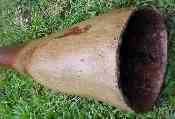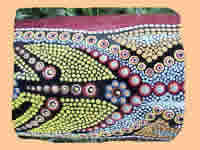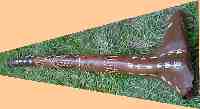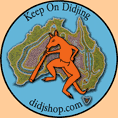Aboriginal Flag Didjes
These didjes have the Aboriginal flag painted on them. Either they have a small flag at the top or the bottom (or both) or the
whole didj is painted in the colours of the Aboriginal flag. You might want to check out the meaning of the Aboriginal flag colours.
To view some didjeridus of this type, click here.
Artifact Didjeridus
These are to be used as artifacts rather than musical instruments. You can play them, but owing to their lower sound quality we
don't recommend them to the serious musician. Having said that, many of these might be useful as cheap beginners didjeridus, in fact their sound
quality is as good as most didjeridus on the market - and their workmanship as high as all of our didjeridus.
To view some didjeridus of this type, click here.
Bark Didjes
Bark didjes are left in their natural bark. Only Ironbark Eucalypts are used for these as their bark is very hard and durable.
In order to leave a didj in its bark it has to be eaten by the termites just right as otherwise they would be very heavy. Consequently these are
very rare.
To view some didjes of this type, click here.
 Bells Bells
Bells are didjeridus which are flared or tapered towards the bottom.
Bells look great and usually result in better sound and/or easier playing. The selection currently online have bottom diameters
between 120 and 150mm.
To view some didjes of this type, click here.
Big Bells
These are even bigger bell-bottom didjes with bottom diameters of over 150mm.
To view some didjes of this type, click here.
 Brad
Gosam Didjeridus Brad
Gosam Didjeridus
One of the best Aboriginal artists in Australia, Brad is certainly in a league of his own.
We feel certain that Brad's artwork is the best quality art available on didgeridoos.
Having trained as a French polisher, Brad Gosam's didjes have a French polishing finish.
To view some didjes of this type, click here.
 Burnt
Didjeridus Burnt
Didjeridus
On these didjeridus artwork is burned into the wood. Aboriginals developed this art form by heating pointed rocks or metal spikes
in the fire and then pushing them into wood.
To view some didjes of this type, click here.
Cheap Learners
To learn circular breathing, you want to have a didj with very good back pressure, so you don't need so much air to keep it going.
Our 'cheap learners' are a selection of affordable beginners didjes. All of these didjeridus are guaranteed to have a clear sound and very good
back pressure.
To view some didjes of this type, click here.
Concert Learners
Many of our medium or high concert didjeridus are also good to learn circular breathing. So if you're looking for a didj to learn
on - but also want a didj you'll never tire of - these didjeridus are what you seek.
To view some didjes of this type, click here.
Didjshop Collection
These didgeridoos are some of the very best we have ever seen out of the tens of thousands of didgeridoos we have handled. They were collected over the years because they are either unique or simply outstanding. Many didgeridoos in this collection are at least ten to fifteen years old.
To view some didjes of this type, click here.
Fine Art Didjeridus
These are didjes with some of the finest Aboriginal art available. All artwork is by Australian Aboriginal people.
To view some didjes of this type, click here.
 Forks Forks
Forks are didjes with two hollow branches going into one trunk.
If the junction is in the lower half of the didj, it can usually be played by two people at the same time.
All Forks allow a single player to switch between two keys while blowing into one mouthpiece. This is achieved by opening or closing
the other mouthpiece of the fork with your hand while playing.
To view some didjes of this type, click here.
Great Players
This is a selection of what we call medium or high concert didjes. We're certain these didjes are among the best in the world.
If you're looking for a didjeridu to use for performance or recording - or simply want to own one of the best didgeridus available, this selection
is for you!
To view some didjes of this type, click here.
Healing Didjeridus
 We
select our healing didjes to have a very good resonance and to be light enough to move around with. We
select our healing didjes to have a very good resonance and to be light enough to move around with.
If you don't need a light didj for your healing work, please contact our customer
help department and ask them to show you some heavier ones.
To view some didjes of this type, click here.
Long Didjeridus
Here you can find didjes which are 6' long or more (over 180cm). Generally these are didjeridus with deeper sounds, but they are
harder to play than shorter didjes. Not recommended for beginners.
To view some didjes of this type, click here.
Painted Didjeridus
This is a sample selection of some of our beautifully painted didjes. All artwork is done by Australian Aboriginal people.
To view some didjes of this type, click here.
Rare Keys
These are didjeridoos in musical keys which are hard to find.
We consider high A, high F, high E, low A, low G#, low G, low F# and low F to be rare keys. Please refer to our Long
Didjeridoos for the lower keys.
To view some didjes of this type, click here.
Travellers Didjeridus
Extra light didjes to lighten the load without compromising sound quality.
Travellers Didjes are also excellent for didj healing work. All Healing Didjes are also great travellers.
To view some didjes of this type, click here.
 Unusual
Shapes Unusual
Shapes
If you'd like something special, here's a rare collection of unusual didjes.
To view some didjes of this type, click here. |
